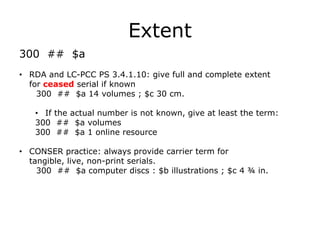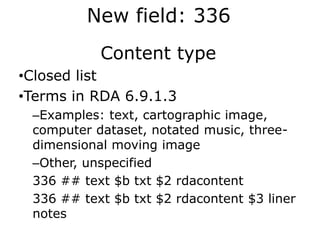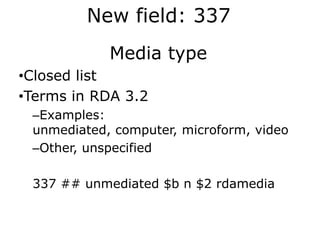Rda for serials
- 1. RDA and serials (the other nutshell) Hi! Beth Thornton Head, Serials Cataloging University of Georgia bethj@uga.edu
- 2. Agenda âĒ General differences âĒ Initial decisions âĒ Title and statement of responsibility âĒ Publication information âĒ Extent, etc. âĒ Frequency âĒ Numbering âĒ A look at an RDA serial record
- 3. ...Iâm guessing youâve heard this already âĒ New fields âĒ 264 âĒ 336, 337, 338 âĒ Changes in transcription âĒ âkey it like you see itâ âĒ abreviations âĒ capitalization
- 4. Initial decisions Parents Parents magazine Parents Parents magazine ...... RDA 2.3.2.13
- 5. Initial decisions University of Georgia Student handbook 2012/2013 Do I need a 110 for this? RDA 19.2.1.1.1
- 6. Initial decisions (2) Okay, I donât need a 110. Do I need a 130? âĒ Check for conflict with *all* works âĒ No more (Online) qualifier So... Print version of: Journal of green energy, issued by the Georgia Energy Commission Electronic version of: Journal of green energy, issued by the Georgia Energy Commission BUT Journal of green energy, issued by some British Green organization Different manifestations of the same work. No need to distinguish. Different work. Needs to be distinguished RDA 6.27.1.9 and the LC PCC PS
- 7. Title and statement of responsibility 245 10 ... annual report 245 10 Annual Turf Grass Conference : $b [proceedings] 245 00 Modern authors / $c Henry W. Wenning, C.A. Stonehill, Inc. Rare Books CNR / Įc THE MAGAZINE OF THE COLLEGE OF NATURAL RESOURCES AT NC STATE UNIVERSITY
- 8. 245 10 $a ... / $c sponsored by the Library Association (founded 1877) and remember: 245 00 Journal of inorganic chemistry $h [electronic resource] Title (2)
- 10. Publication information (2) 264 #1 $3 <1976->: $a New York, New York : $b Alan R. Liss, Inc. 264 31 $3 <2005->: $a Hoboken, New Jersey : $b Wiley-Liss, Inc. 264 #1 $a [Reston, Va.?] : $b U.S. Department of the Interior, Geological Survey 264 #2 $a Washington, D.C. : $b Superintendent of Documents, U.S. Government Printing Office
- 11. Publication information (3) 264 #1 $a Edinburgh : $b John Carfrae, $c 1824. 264 31 $3 Feb. 16- Apr. 2: $a Edinburgh : $b J. L. Huie 362 1# Began with number 1 (Jan. 7, 1824); ceased with number 38 (Apr. 2, 1824).
- 12. Extent 300 ## $a âĒ RDA and LC-PCC PS 3.4.1.10: give full and complete extent for ceased serial if known 300 ## $a 14 volumes ; $c 30 cm. âĒ If the actual number is not known, give at least the term: 300 ## $a volumes 300 ## $a 1 online resource âĒ CONSER practice: always provide carrier term for tangible, live, non-print serials. 300 ## $a computer discs : $b illustrations ; $c 4 Âū in.
- 13. New field: 336 Content type âĒClosed list âĒTerms in RDA 6.9.1.3 âExamples: text, cartographic image, computer dataset, notated music, three- dimensional moving image âOther, unspecified 336 ## text $b txt $2 rdacontent 336 ## text $b txt $2 rdacontent $3 liner notes
- 14. New field: 337 Media type âĒClosed list âĒTerms in RDA 3.2 âExamples: unmediated, computer, microform, video âOther, unspecified 337 ## unmediated $b n $2 rdamedia
- 15. New field: 338 Carrier type âĒClosed list âĒTerms in RDA 3.3 âExamples on next slide âOther, unspecified 338 ## volume $b nc $2 rdacarrier
- 16. 338 carrier type examples
- 17. 245 $h 336, 337, 338 replace the 245 $h.... 336 ## $a text $b txt $2 rdacontent 337 ## $a computer $b c $2 rdamedia 338 ## $a online resource $b cr $2 rdacarrier
- 18. Example: print 300 ## $a 417 pages ; $c 24 cm 336 ## text $b txt $2 rdacontent 337 ## unmediated $b n $2 rdamedia 338 ## volume $b nc $2 rdacarrier
- 19. Example: e-book 300 ## $a 1 online resource 336 ## $a text $b txt $2 rdacontent 337 ## $a computer $b c $2 rdamedia 338 ## $a online resource $b cr $2 rdacarrier
- 21. Frequency 310 âĒ RDA 2.1.4 âĒ Not a core element âĒ CONSER requires current frequency Numbering 362 1# $a and 588 âĒ RDA 1.7, 1.8, 2.6 âĒ Transcribe elements as found 362 1# Began with volume 1, number 1 (June 2005). 588 ## Description based on: Volume 5, number 1 (June 2011); title from cover. 588 ## Latest issue consulted: Volume 6 number 1 (June 2012).
Editor's Notes
- #3: In general, the differences for serials (apart from the new fields) are pretty subtle.the plan: look at describing a serial from top to bottom, highlighting in general terms whatâs the same and whatâs different. At the end weâll look together at an RDA serial record. More detail on this will come in a full class. Also itâs important to note that we are all learning this together and so best practices arenât fully in place.
- #4: Iâm assuming that you know general differences: 3xx fields, capitalization, abbreviations, etc. So this is a quick review. You will see more in examples.336 = Content type: Content type is: expression level.It is the form of communication in which the content is expressed.337 = Media type: the type of intermediation device required to view, play, run, etc. the content of a resource.336 = Carrier type: type of carrier used to convey the content of the resource.There are more than these, of course.And it applies to serials too.
- #5: The first thing I do is see if I can fit my pieces in hand onto an existing record (though if the pieces have found their way to me....it usually means there is some sort of problem....)âtitle changeâ rules have been carried over to RDA.
- #6: If you are working with copy, this decision will have been made for you, hopefully.One of the hardest decisions in serials cataloging, for me, is whether a serial fits one of the scenarios for corporate main entry. the good news is: the creteria havenât changed! They just live in a different place (and we no longer say âmain entryâ)That rule used to be AACR2 21.1b2. You can find instruction at RDA 19.2.1.1.1 and the related policy statement.19.2.1.1.1 = corporate bodies considered to be creators(the authorized access point for a work is AAP for creator, if applicable and the preferred title for the work)So, in order to enter a corporate body as a creator, they have to fit the 19.2.1.1.1 criteria. Which are the same as teh 21.1b2 criteria....
- #7: so, we donât just check for conflict with other serials anymore. Include authority records, monographs, serials, etc. We compare the entire authorized access point (1XX if there and 245)We are still discussing best practices for qualifiers.If we have a âgeneric titleâ we are advised to prefer a corporate body qualifier. Otherwise, itâs judgement.
- #8: The dot dot dot.No more $b [proceedings]Jury still out regarding best practices with 245 $c for serials.It is an RDA core element. But not Core for CONSER. We are instructed to âprovide if important for identification of the serialâRDA says we donât need to transcribe editors unless the name of the editor is considered to be an important means of identifying the serial (e.g., if a particular person edited the serial for all or most of its existence; if the person's name is likely to be better known than the title of the serial). 2.4.1.4Transcribe as you see it.Last example illustrates 1) capitalization and 2) noun phrases treated as part of the statement of responsibility.
- #9: Generally with RDA we donât omit âextra stufâ from SOP
- #10: Note that best practice for serials is not to use a copyright date. Because a serial can have many copyright dates.Right now we are struggling with 264 in legacy records.....
- #11: No dates in 264 because desc not based on first issue in either one of these examples.Fewer abbreviations. If a word is spelled out on a piece, thatâs how you transcribe it. If itâs abbreviated, then you transcribe the abbreviation. So if I see Inc. in an RDA record, I assume it appeared like that on the piece.
- #13: Optionally you can provide âvolumesâ for live serials in other formats.Abbreviations:Here you can use in. (thatâs in appendix B) and cm (no period because itâs considered a symbol)âunless you have a series statement and are using ISBD punctiation.
- #21: Hereâs an example of a ceased serial.Note 300 is filled in.Note 260: this is an âolderâ rda record.
- #22: Note: capitalization is an instutitional policy. Follow Appendix A or âtake what you seeâ
- #23: Review how to tell this is an RDA record.I like this example because it shows what serials do for title access. See the 246? With monos, if there is weirdness/typos on piece, they are transcribed. For serials, record it correctly in the 245. So a typo would have been handled the same way.264: option to use ... not identified but try to supply if you can.
- #24: This one illustrates something that I didnât bring up.....RDA brings the end of that giant RI that basically says to ignore the A2 chapter 11 (microforms). Many of the things we transcribed were from the *original* work. Here is an example of a serial microfilm. Note no 245 $h, and the 3XX fields.776 field.I am not comfortable with this idea yet but here it is.

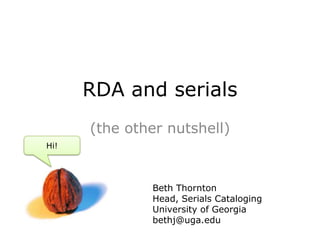
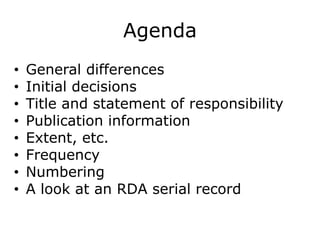




![Title and statement of
responsibility
245 10 ... annual report
245 10 Annual Turf Grass Conference : $b [proceedings]
245 00 Modern authors / $c Henry W. Wenning, C.A.
Stonehill, Inc. Rare Books
CNR / Įc THE MAGAZINE OF THE COLLEGE OF NATURAL
RESOURCES AT NC STATE UNIVERSITY](https://image.slidesharecdn.com/rdaforserials-130617152059-phpapp02/85/Rda-for-serials-7-320.jpg)
![245 10 $a ... / $c sponsored by the Library Association
(founded 1877)
and remember:
245 00 Journal of inorganic chemistry $h [electronic resource]
Title (2)](https://image.slidesharecdn.com/rdaforserials-130617152059-phpapp02/85/Rda-for-serials-8-320.jpg)

![Publication information (2)
264 #1 $3 <1976->: $a New York, New
York : $b Alan R. Liss, Inc.
264 31 $3 <2005->: $a Hoboken, New
Jersey : $b Wiley-Liss, Inc.
264 #1 $a [Reston, Va.?] : $b U.S.
Department of the Interior, Geological
Survey
264 #2 $a Washington, D.C. : $b
Superintendent of Documents, U.S.
Government Printing Office](https://image.slidesharecdn.com/rdaforserials-130617152059-phpapp02/85/Rda-for-serials-10-320.jpg)

